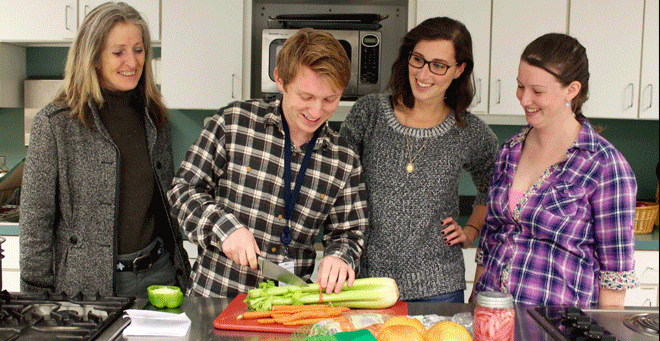 |
|
|
Jeffrey Larnard cuts celery for a recent class while (from left) Barbara Olendzki, Sydney Greenberg and Molly Cain observe. |
Ten-spice vegetable soup enriched with cashew cream; spinach feta turkey burgers on whole wheat buns garnished with pickled red onions; and for dessert, pumpkin yogurt mousse topped with crunchy granola.
These dishes were not served at a gourmet restaurant, but prepared from scratch by 16 UMass Medical School students enrolled in the Cooking for the Everyday Eater class. It is a student-initiated optional enrichment elective for the School of Medicine and Graduate School of Nursing that teaches hands-on cooking skills and the overall nutritional values of real foods, not just their biochemical components.
“This class tries to make healthy eating more concrete,” said course co-founder Jeffrey Larnard, SOM ‘17. “Our main goal is to improve the health of the students themselves.”
Larnard, who earned his Bachelor of Science in human nutrition at UMass Amherst, created Cooking for the Everyday Eater with fellow third-year medical student Sydney Greenberg to help students translate the biochemistry of nutrients—which are taught in the formal curriculum—into practical ways to improve their own dietary habits, as well as develop confidence in counseling patients about nutrition.
“The goals of the elective that we have designed is to teach students basic culinary skills that are key to achieving good personal nutrition as well as to educate future physicians on dietary issues that are critical for better patient outcomes,” Larnard and Greenberg wrote in their course proposal. “We hope to enable students to better take care of themselves and their future patients by teaching cooking skills and practical, food-based nutrition.”
Cooking for Everyday Eaters is inspired by the Goldring Center of Culinary Medicine at Tulane University School of Medicine, whose mission is to prepare future physicians to serve and heal patients and communities through innovative nutrition curriculum and hands-on training in the culinary arts. Larnard and Greenberg likewise strive to teach medical and nursing students about how to cook and what to eat in order to help patients improve their diet and, ultimately, their health.
While some students like Larnard, Greenberg and second-year medical student Molly Cain, who helps them teach the class, are already experienced cooks who make health-conscious food choices, many students admit to less than exemplary eating and cooking habits.
“One thing that’s hard for time-pressed med students is meal planning, including using the same ingredients and recipes in multiple ways. We try to get people to use ingredients they might not have otherwise, or use the same ingredient a different way,” said Greenberg, a self-professed foodie and former high school teacher. “Most of the recipes take about an hour or less to cook and make big batches that can be frozen. And they’re all nutritious.”
The five-week class includes an introduction to nutrition, macronutrients and meal planning; dietary considerations for cardiovascular disease and type 2 diabetes, the major chronic conditions for which diet plays a particularly large role in both prevention and treatment; weight management focusing on portion sizes and low- and no-calorie ways to build flavor; and gluten-free and dairy-free cooking, focused on healthy alternatives for those individuals who must, or choose to, eliminate gluten or dairy from their diets.
Once the meal is cooked and everyone is seated for dinner, each class ends with discussion of patient cases presented by faculty advisor and dietitian Barbara Olendzki, RD, MPH, LDN, assistant professor of medicine and nutrition program director of the Medical School’s Center for Applied Nutrition. Using real cases adds to the discussion issues that can affect patient care including comorbidities, cultural beliefs and socioeconomic factors.
For example, in analyzing the food diary of an overall healthy 20-something who wants to lose a few pounds, students agreed they would recommend that the patient cut down on liquid calories consumed in so-called “health” drinks that are loaded with sugar, as well as any alcoholic beverages. Another practical recommendation for this individual would be to try reducing portion sizes while continuing to eat the same foods. More challenging but in some ways easier to address because there is so much room for improvement are cases like that of a man with pre-diabetic metabolic syndrome who likes to work out and barbecue. For him, students agreed, more frequent workouts, less steak and more vegetables, and not skipping breakfast and lunch in favor of a huge dinner, could help tip the scales in the right direction.
The course also takes into account the varying levels of cooking skills among its participants, so that while more experienced cooks can enhance their skills, recipes and techniques are simple enough to help less experienced cooks acquire confidence with basic techniques. First-year medical student Abigail Finger took the class because she wanted to learn new, easy recipes in order to eat healthier and be more inclined to cook for herself more frequently. Eddy Adams, also a first year student, had never cooked a meal in his life before coming to medical school.
“It’s been a bit of struggle learning how to provide food for myself,” Adams said. “I’ve learned quite a bit in the class. Now I’m focusing on things I can make ahead and freeze.”
Related link on UMassMedNow:
T&G: Healthy cooking classes help educate doctors